Many common names of plants reflect man’s close relationship with farm animals. On the porcine list there’s more than a dozen Pigweeds in the United States, several Sow Thistles, Swinecresses, and quite a few Hog Plums one of which is fruiting locally, Ximenia americana.
Also known as the Tallow Plum it supposedly fruits all year but I’ve only seen fruit on my local species in the summer or fall. You can find it in scrubby, dry, sandy ground usually with saw palmettos and scrappy little oaks and the like. Also all my finds have also be within a few miles of the coast. Quickly perishing off the tree, they have a soft avocado texture and a lime-like flavor, tart but sweeet as well. The seed oil is edible but the seed is not beyond just a few. Very young leaves are edible thoroughly boiled but I have ot tried that because they do contain what would be cyanide. The species also has a lot of herbal uses. What’s also interesting is that the shrub can be parasitic. To read more about the Tallow or Hog Plum, go here.
When you see a good idea, let people know about it! I saw this posted by Tony Troler on Facebook ( Edible Wild Plants page) and got his permission to post it here. The bane of harvesting edible parts off cacti are spines, not only big ones but in particular very small ones called glochids, which are hair-like and about an eight-inch ling that can make your life miserable and make you swear and swear off cactus. The spines can be washed off the fruit and burned off but here we see a different technique: Brushed off. Tony said he saw some native doing something similar so he built a screen box and got a couple of brooms. It’s made of two-by-fours and hardware cloth (think of it as screen on steroids.) If you were diabolical you could save the spines for torturous itching powder but we won’t get into that…
You can see the despining is in two stages. First is sweeping them around the big box rolling them against the screen to get most of the spines off. The second stage is brushing with a smaller hand brush to make sure all the spines and glochids are removed. If you are going to harvest cactus fruit, “tuna” as they are called, I recommend you get a heavy pair of gloves and use them only for that purpose. The glochids can work their way through lesser gloves. Once cleaned there’s a variety of things that can be done to the tasty fruit and their seeds. To read more about Cactus click here.
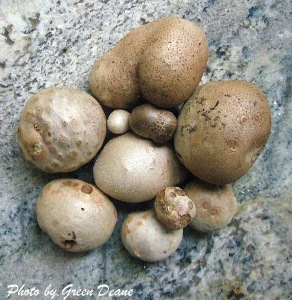
Vines that produce round “air potatoes” from tan to dark brown to red do not have the root we want to find. Photo By Green Deane
There are at least six true yams in Florida and the greater south eastern United States. (For marketing reasons sweet potatoes —Ipomoeas— were and are called “yams” but are not actually yams thus not considered here with the true yams.) Two true yams are native and not of any edible interest, Dioscorea floridana and D. villosa (the latter was the original source of chemicals for birth control pills.) D. sansibarensis is rare and toxic and shows up only in the southern tip of Florida. It’s “air potatoes” — how many yams reproduce vegetatively — can actually be dark red to blue red. We have no interested in them. D. polystachya (Yam C on my parent website EatTheWeeds.com) is found in only one northern Florida county but is found in 25 other states and is naturalized in a wide swath from Maryland west to about Arkansas including much of the Virginias and Carolinas as well as southern Ohio and northern portions of the gulf states. I have seen it while hiking in western North Carolina near Tennessee. It has edible small air potatoes and skinny roots. Also called the Chinese Yam it has been long cultivated for food.
Locally that leaves two more Dioscorea, the alata and the bulbifera, Yam A and Yam B respectively on the my website. D. bulbifera is of secondary interest to us. While its root can be boiled twice and eaten it doesn’t seem to root much here in Florida. Even at the end of a long vine I usually find only this year’s rooting air potato and not a true root storing energy. In places like Australia it does put on softball-sized roots and is consumed but finding a root here is unusual. It has round air potatoes, either tan or dark brown often with light or dark warts. The key is they are roundish and we are not interested in them. That leaves one yam left and that is the prime D. alata, Yam A on my parent site. Its root is staple food and the largest caloric payoff in Florida from a foraging calories-in/calories-out point of view (and it can be cultivated in colder climates where there is no threat of escaping.) The easiest way to find D. alata is to start looking now for its distinctive air potatoes. We use its air potatoes to find the vine to find the edible large root. Its air potatoes are not round. They are misshapen and dark brown, occasionally green to white at the tip. They are shaped like an I or an L or a Y or a lump or combinations there of. But, they are not round. While there are many other characteristic to identify the alata, this time of year the easiest thing to do is study all the air potatoes vines you see and look for misshapen dark brown air potatoes. You can read more about D. alata, Yam A, here, D.polystachya, Yam C, here, and D. bulbifera, the lesser of the three, Yam B, here.
If you have been looking for beautyberries and have not been able to find them now is the time to go scouting. Locally bushes are very heavy with ripe berries. Nearly every mother where these berries grow have told their children the berries are poisonous. They are not but raw they are rather insipid. However they can be dried to make an anti-oxidant tea and when processed make a very pretty and tasty jelly. Most objections to the plant comes from its berries having a mild flavor and its leaves being rather smelly. However those leaves can be used as an insect repellant (externally.) To read more about the Beautyberry, go here.
Upcoming Foraging Classes: If you sent me an email about a birthday forage in October email me again. I had some mail issues and that email was lost. Here is the current schedule: Saturday, September 20th, Spruce Creek Park, 6250 Ridgewood Ave. Port Orange, FL 32127, 9 a.m.; Sunday, September 21st, Wickham Park, 2500 Parkway Drive, Melbourne, FL 32935-2335, 9 a.m. Sunday, September 28th, Bayshore Live Oak Park, 23000 Bayshore Rd., Port Charlotte, FL 33980, 9 a.m. Saturday, October 4th Mead Garden,1500 S. Denning Dr., Winter Park, FL 32789, 9 a.m. We will be sharing the park with bird watchers… just to let you know…; October 18/19 TBA; Saturday, October 25th, Bayshore Live Oak Park, 23000 Bayshore Rd., Port Charlotte, FL 33980, 9 a.m. For more details click here.
Eat The Weeds On DVD. My foraging videos do not include alligators but they do cover dozens of edible plants in North America. The set has nine DVD. Each DVD has 15 videos for 135 in all. Some of these videos are of better quality than my free ones on the Internet. They are the same videos but many people like to have their own copy. I burn and compile the sets myself so if you have any issues I handle it. There are no middle foragers. And I’m working on adding a tenth DVD. To learn more about the DVDs or to order them click here.
On the Green Deane Forum we post messages and pictures about foraging all year-long. There’s also a UFO page, for Unidentified Flowering Objects so plants can be identified. Recent topics include: Berry Tree of Some Sort, Need a Smile? Processed foods are Diabolical, Bean/Pea Pod, Florida Makes Living off the Grid Illegal? Concord Grapes Anyone? Hazelnuts, Botanical Vick’s Inhaler, Persimmons, Tomato Advice, A goldenrod of Sorts, Foraging Rules, American Beautyberry, and Another Olive Like Fruit. The link to join is on the right hand side of this page.
If you would like to donate to Eat The Weeds please click here.

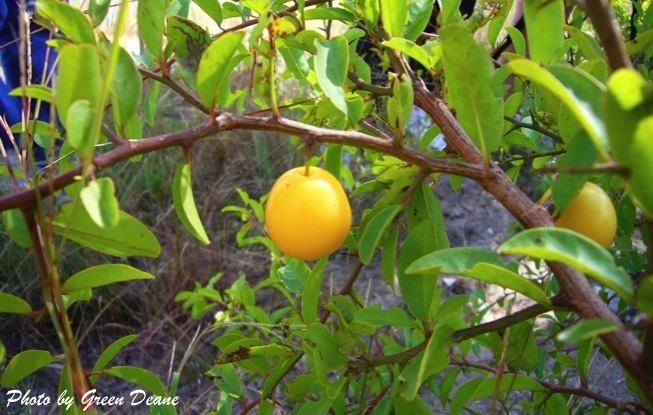
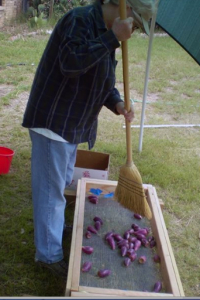
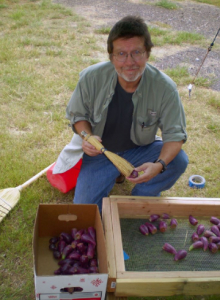
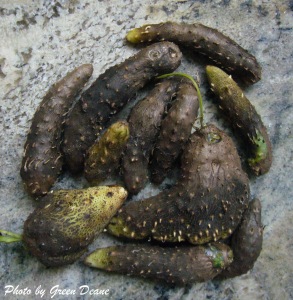
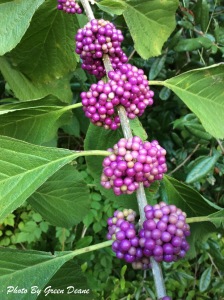
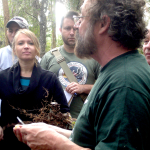



Deane,
what about Discorea batatas? the perennial-
It says everywhere that the little round bulbils/air roots are very good eating, and the underground root as well…is this true?
They might be misnamed. Read my article on Chinese Yam.
Your photo of the correct ‘air potato’ is a huge help. I’ve been trying to follow the twist-direction of vines everywhere I see suspects but my job has now been made easier. Thank you!
I believe in “He who does’nt thank people, does’nt thank God”. Hence I should like to thank you for this issue of Eattheweeds and your article on Cactus: Don’t be Spineless. I also ssy thank you for Tony Troler for the clever method he dealt with the big spines and glochids (addition to my vocabulary ). In every day life we encounter examples of removing such matter e.g. in shaving (ladys and gents) or when preparing poultry – chicken or turkey – before cooking.
Among other cactii as ornamentals in my garden, I have: Opuntia littoralis and Gymnocalycium baldianum. Now fo more than two years the first hasn’t yet blossomed. In Yemen I usef to see many eating the fresh fruit brought from the wild and sold in the streets of the capital Sana’a. Usually they use their knives which are so designed to fit in a leather belt decorating the waist (emblem) ;cutting and scraping to enjoy eating the pulp. On the other hand, the G. Baldianum is nowadays is being kind enough to make us happy to watch its scarlet red wonderful flowet though that is only in day light. This is the second year we enjoy the view; but with no fruit. Lookin from above, I could see the central flower encircled by several fading ones while at the bottom some cotton like material covered the spiny ground. That said, I must say I’m confused as to where to put safely eacf of my two cactii: into which box that belonging to N.cochinillifer or that belonging to O.cochinillifer!
Sighs…
Maybe its there and I just don’t see it…
I wonder if you have a way to see your plant info based on time of year they show up!
I tried to search by month but only came up with posts made talking about things I’m not looking for at the moment. There is soooo much to learn and “weeding” through it all for my “pea brain” makes it really difficult.
How or where would I look, through your site, to find plants to forage based on time of year they are available? I’m in SC if that is pertinent.
Well… my weekly newsletter usually includes what I see that week while out foraging, meaning that’s in season. And my videos are in seasonal order starting in January.